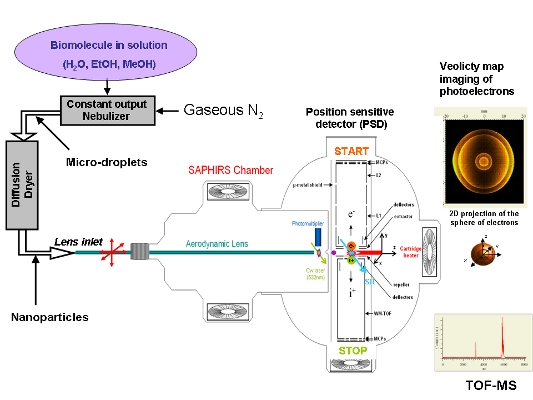PhotoBIO
Contact LISA: Martin Schwell
PI: M. Schwell
The project "PhotoBIO" aims to study the photochemistry of biomolecules of small and medium size (up to 1000 u.m.a.) in the far UV (VUV) using photoionization mass spectrometry and electron spectroscopy. Synchrotron radiation (SR) is used as tunable VUV light source so that wavelength dependant data are obtained.
The general motivation for these studies comes from a fundamental question of exobiology, i.e. what would be the chances of survival of prebiotic and biological molecules in the interstellar medium (ISM), planetary or cometary atmospheres with respect to radiation fields prevailing in these regions.
Exploring the photochemistry of biological molecules in the VUV is of considerable interest because of the possible delivery of such molecules from space to the early Earth (or other planetary bodies), and the role they could have played for the origin and the development of life there.
In this project, small biomolecules are studied in the gas phase because only one in the gas phase intrinsic properties of these molecules, such as absorption or ionization cross section as well as elementary photoreactions and their branching ratios, are measured. In the frame of this project, the SAPHIRS instrument installed at the DESIRS beamline of the synchrotron SOLEIL, is used. It integrates a time-of-flight mass spectrometer and an electron spectrometer.
A new nanoparticle source has been also developed for this instrument in order to study thermally fragile and/or non-volatile biomolecules. Thermo desorption of nanoparticles consisting of pure biomolecules is a new methodology which propagates these molecules effectively to the gas phase in a very gentle manner and therefore enables one to study fragile molecules with very low volatility.

Figure : Set-up expérimental du projet « PhotoBIO ». Les nanoparticules biologiques sont produites par nébulisation d’une solution aqueuse d’un composé biologique pure. Ensuite, les microgouttelettes produites sont séchées à l’aide d’un dryer à diffusion. Les nanoparticules ainsi produites, consistant d’une substance biologique pure, entrent subséquemment dans l’appareil SAPHIRS (installé de manière permanente sur la lige de lumière SAPHRIS à Soleil. Des éléments nouvellement développés sur SAPHIRS incluent 1) une lentille aérodynamique pour la focalisation spatiale des nanoparticules, 2) un système à détection optique des particules pour l’alignement et le contrôle de la stabilité du jet à particules, et 3) un thermodésorbeur intégré directement dans la source d’ion de SAPHIRS. Les particules impactant y sont vaporisées

